
Stylidium is a genus of dicotyledonous plants that belong to the family Stylidiaceae. The genus name Stylidium is derived from the Greek στύλος or stylos, which refers to the distinctive reproductive structure that its flowers possess. Pollination is achieved through the use of the sensitive "trigger", which comprises the male and female reproductive organs fused into a floral column that snaps forward quickly in response to touch, harmlessly covering the insect in pollen. Most of the approximately 300 species are only found in Australia, making it the fifth largest genus in that country. Triggerplants are considered to be protocarnivorous or carnivorous because the glandular trichomes that cover the scape and flower can trap, kill, and digest small insects with protease enzymes produced by the plant. Recent research has raised questions as to the status of protocarnivory within Stylidium.

The family Stylidiaceae is a taxon of dicotyledonous flowering plants. It consists of five genera with over 240 species, most of which are endemic to Australia and New Zealand. Members of Stylidiaceae are typically grass-like herbs or small shrubs and can be perennials or annuals. Most species are free standing or self-supporting, though a few can be climbing or scrambling.

Stylidium repens, the matted triggerplant, is a dicotyledonous plant that belongs to the genus Stylidium. S. repens is endemic to Australia and is found primarily in southwest Western Australia. This species is a creeping or scrambling triggerplant, which can spread over large areas as a tangled mat of stems and aerial roots. The older stems are grey whereas younger stems appear red and have terminal rosettes of small leaves, five mm to one cm in length. When the rains come, new roots and a one to three flowers emerge from the terminal rosettes. This is the only species of triggerplant known to regularly flower twice a year—in autumn and late spring. Pollination, which is typically very specialized in this genus, is achieved with a variety of insects in this species.
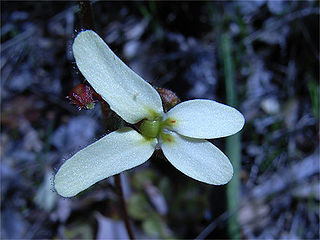
Stylidium hispidum, the white butterfly triggerplant, is a dicotyledonous plant that belongs to the genus Stylidium. S. hispidum is endemic to Australia and is found primarily in southwest Western Australia near Perth. This species is a basally rosetted triggerplant with greyish, linear leaves growing up to three cm. The scape is reddish, from six to thirty cm tall ending in a somewhat branched raceme giving rise to white or cream-colored flowers, which have red spots near the throat of the flower. The primary habitat for S. hispidum includes jarrah forests, gravelly loams, and light sandy soils.
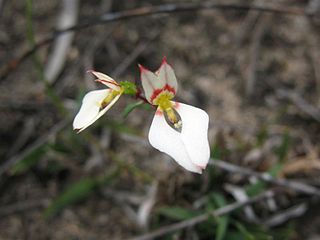
Levenhookia, also known as the styleworts, is a genus of ten recognized species in the family Stylidiaceae and is endemic to Australia. The genus is restricted to Western Australia almost exclusively with a few exceptions: L. pusilla's range extends into South Australia, L. dubia's range extends through South Australia into Victoria and New South Wales, L. sonderi is native only to Victoria, and L. chippendalei is also found in the Northern Territory.
Levenhookia chippendalei is a dicotyledonous plant that belongs to the genus Levenhookia. It is named after its discoverer, George Chippendale, founder of the Northern Territory Herbarium. It grows from 8–18 centimetres (3.1–7.1 in) tall with oblanceolate leaves near the base of the plant. The few leaves this species produces are generally 2 millimetres (0.079 in) long. The inflorescences are racemose. Flowers are pink with 4–5 millimetres (0.16–0.20 in) long petals. The sensitive labellum is hood-like and dark red with yellow appendages. L. chippendalei is most closely related to L. preissii but differs in flower morphology. It shares a similar floral arrangement with Levenhookia stipitata.
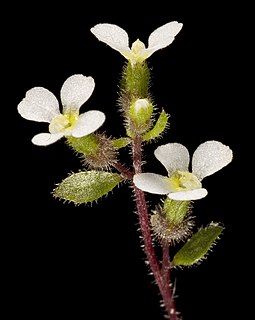
Levenhookia dubia, the hairy stylewort, is a dicotyledonous plant that belongs to the genus Levenhookia. It is an ephemeral annual that grows from 2–6 centimetres (0.79–2.36 in) tall with obovate leaves that are generally 2–5 millimetres (0.079–0.197 in) long. Flowers are white and bloom from September to October in its native range. L. dubia is most closely related to L. sonderi, which has been described as a variety of L. dubia in the past. It is endemic to Australia and has native ranges in Western Australia, South Australia, New South Wales, and Victoria. Its habitat has been reported as being sandy soils in granite outcrops.
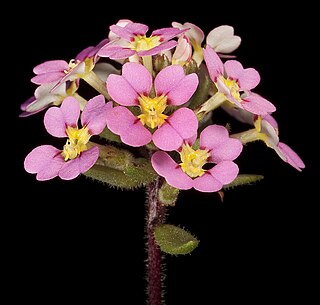
Levenhookia leptantha, the trumpet stylewort, is a dicotyledonous plant that belongs to the genus Levenhookia. It is an ephemeral annual that grows from 2–6 centimetres (0.79–2.36 in) tall with ovate to lanceolate leaves that are generally 2–5 millimetres (0.079–0.197 in) long. Flowers are pink and bloom from September to October in its native range. It is endemic to Western Australia. Its habitat has been reported as being sand or sandy clay soils in granite outcrops and winter-wet depressions.

Levenhookia pauciflora, the deceptive stylewort, is a dicotyledonous plant that belongs to the genus Levenhookia. It is an ephemeral annual that grows from 5–10 centimetres (2.0–3.9 in) tall with ovate to suborbicular leaves. Flowers are white and bloom from September to November in its native range. L. pauciflora is endemic to Western Australia where it grows in sandy soils in sandstone or granitic areas. The flowers of L. pauciflora resemble those of Stylidium ecorne and it has been said that S. ecorne mimics L. pauciflora to take advantage of its pollinators.

Levenhookia preissii, Preiss's stylewort, is a dicotyledonous plant that belongs to the genus Levenhookia.
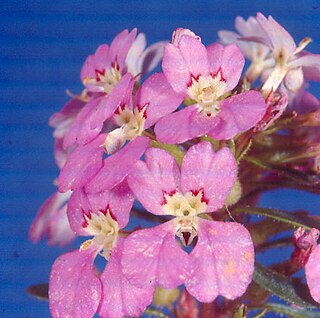
Levenhookia pulcherrima, the beautiful stylewort, is a dicotyledonous plant that belongs to the genus Levenhookia. It is an ephemeral annual that grows on average from 7–8 centimetres (2.8–3.1 in) tall. Lower leaves are spathulate while upper leaves are oblanceolate and up to 1.8 centimetres (0.71 in) long. Stems and older leaves are red. Flowers are pink to rose-coloured with the shorter anterior petals about 3 millimetres (0.12 in) long. The sensitive labellum is obovate and white with a circular grey-purple mark on either side of the terminal portion. Both leaves and stems of L. pulcherrima possess more glandular trichomes than in other Levenhookia species. When describing this new species, Sherwin Carlquist noted that it is most closely related to L. preissii and L. pauciflora, which might place it with those species in section Levenhookia, but Carlquist neglected to specifically say so. He also noted that several features of this species, including its corolla lobe, labellum, throat appendage, and stigma morphology, are distinctly different from those species with which it appears to be associated. L. pulcherrima is endemic to southwestern Western Australia.
Levenhookia pusilla, the midget stylewort or tiny stylewort, is a dicotyledonous plant that belongs to the genus Levenhookia. It is an ephemeral annual that grows about 5 to 6 cm tall with suborbicular to ovate-spathulate leaves. Flowers are pink to white and bloom from September to December in its native range. L. pusilla is endemic to southwestern Western Australia and South Australia where it grows in granitic or lateritic soils.
Levenhookia sonderi, the slender stylewort, is a dicotyledonous plant that belongs to the genus Levenhookia. It is an ephemeral annual that grows only in Victoria, Australia. L. sonderi is most closely related to L. dubia and it has even been described as a variety of L. dubia in the past. Johannes Mildbraed was the first person to reduce L. sonderi to a variety of L. dubia in his 1908 taxonomic monograph on the Stylidiaceae in which he noted he could not find any significant difference between L. sonderi and L. dubia to maintain the separate taxonomic treatment of the two species. Later studies have considered the species to be distinct.

Levenhookia stipitata, the common stylewort, is a dicotyledonous plant that belongs to the genus Levenhookia. It is an ephemeral annual that grows about 7–10 centimetres (2.8–3.9 in) tall with oblanceolate to linear leaves. Flowers are pink and bloom from August to January in its native range. L. stipitata is endemic to southwestern Western Australia where it grows in granitic or lateritic soils. This species was first described by George Bentham in 1837 as Stylidium stipitatum and was later reclassified into the genus Coleostylis, which was placed into synonymy with the genus Levenhookia.

Levenhookia sect. Coleostylis is a section of four recognized species in the family Stylidiaceae. It was established and described by Johannes Mildbraed in 1908 to separate the subgeneric taxonomy in the genus Levenhookia. Mildbraed originally placed L. preissii and L. stipitata in this section. L. chippendalei was described in 1966 and placed in this section by Rica Erickson and Jim Willis. Section Coleostylis could also contain L. octomaculata, which Erickson described in 1956, noting its affinities with L. stipitata but without placing it in a section. Otherwise it would be unplaced as to a section.
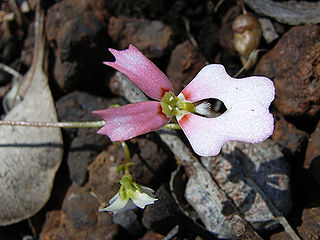
Stylidium calcaratum, the book triggerplant, is a dicotyledonous plant that belongs to the genus Stylidium. It is an ephemeral annual that grows from 5 to 10 cm tall but can grow larger at 20–30 cm tall in damp forest or scrub habitat. The few ovate leaves produced by this plant form basal rosettes around the stem. The leaves are around 3–5 mm long on short petioles. The scapes are 2–30 cm tall and produce single flowers in smaller plants and up to nine flowers in larger, more robust plants. Flowers are pink or white with red spots or lines at the individual petal bases. The petals are vertically paired and will fold over to meet each other at night or in adverse weather conditions. S. calcaratum is endemic to Australia and has a distribution that ranges from Victoria through South Australia and into Western Australia. Its habitat is recorded as being wet flats or near creeks and seepages. Pollination is achieved by a grey fly, Comptosia cuneata.
Stylidium ceratophorum is a dicotyledonous plant that belongs to the genus Stylidium. It is an annual plant that is endemic to the Kimberley region of Western Australia and northern parts of the Northern Territory. It attains a height of 12–30 cm with a basal rosette of small leaves. The leaves are petiolate, obovate, or lanceolate and are only 0.2–1 cm long. Solitary scapes are produced that bear golden yellow or orange flowers, 7–9 mm across. Its habitat has been reported as being sandy soils on creek margins in the presence of Stylidium rubriscapum and Stylidium diceratum or in river paperbark stands. S. ceratophorum appears similar to S. diceratum and may be confused with the species since they both have orange flowers. S. ceratophorum's corolla is twice as large as S. diceratum, though, as well as the deeply divided posterior corolla lobes of S. ceratophorum.

Stylidium ecorne is a dicotyledonous plant that belongs to the genus Stylidium. It is an annual plant that grows from 5 to 12 cm tall. It has pale or bright pink flowers and occurs in swampy areas.
Stylidium longicornu is a dicotyledonous plant that belongs to the genus Stylidium. It is an annual plant that grows from 10 to 30 cm tall. The obovate to spathulate leaves form a basal rosettes around the stem. The leaves are around 4–6 mm long. Inflorescences are unbranched racemes and produce flowers that are violet with white at the base and bloom from June to August in their native range. S. longicornu is endemic to the Kimberley region in Western Australia. Its habitat is recorded as being sand flats near sandstone. It grows in the presence of S. lobuliflorum, Rhynchospora, and Leptocarpus.

Telopea truncata, commonly known as the Tasmanian waratah, is a plant in the family Proteaceae. It is endemic to Tasmania where it is found on moist acidic soils at altitudes of 600 to 1200 m (2000–4000 ft). Telopea truncata is a component of alpine eucalypt forest, rainforest and scrub communities. It grows as a multistemmed shrub to a height of 3 metres (10 ft), or occasionally as a small tree to 10 m (35 ft) high, with red flower heads, known as inflorescences, appearing over the Tasmanian summer and bearing 10 to 35 individual flowers. Yellow-flowered forms are occasionally seen, but do not form a population distinct from the rest of the species.













